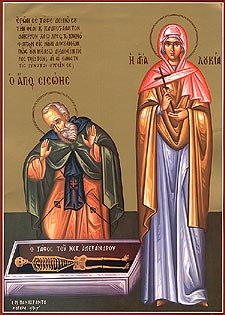|
|||
|---|---|---|---|
| This weekly bulletin insert complements the curriculum published by the Department of Christian Education of the Orthodox Church in America. This and many other Christian Education resources are available at http://dce.oca.org. | |||

Saint Sisoes the Great was known for his holy life and deep humility. Born in Egypt, Sisoes was an admirer of Saint Anthony. After Anthony died, he went to live on the mountain Anthony had once inhabited, and worked for many years to fill his life with prayer, putting aside his own desires and working against temptations. Like other great saints he was sought out, even in his relative isolation, by earnest Christians who wanted to benefit from his spiritual wisdom. Because his counsel was so highly valued they wrote down some of his words, and so we have them today. Sisoes always seems to have stressed two things in speaking with the people who came to him: first, sincere humility and second, mindfulness, which means doing everything you do thoughtfully and with a clear intention. One example of his counsel shows how he urged both these important things. A monk came to him, asking his advice about how to pray. Describing his prayer efforts the monk said, "Father, I always place myself in the presence of God." Sisoes discerned that the man had a good intention, which was to come closer to God. But his answer was: "It would be much more to your advantage to place yourself below every creature, in order to be sincerely humble." The saint's personal humility was an object of admiration and even awe. Sisoes rarely spoke, because he regarded silence as one aspect of humility—not placing importance on one's own words and ideas, and being ready to hear what God is saying. Being around him, people noted, was always a strong reminder of the shallowness and needlessness of much of our casual conversation. But another aspect of humility is self-criticism, and so this silent man said of himself: "I am now thirty years praying daily that my Lord Jesus may preserve me from saying an idle word, and yet I am always relapsing." Sisoes died in about the year 429, with his monks around him. He had taught them well how to serve the Lord. With death approaching, the monks said, his face shown like the sun as he prepared to enter the Lord's presence. Romans 6: 18-23 might be called an explanation of the way Sisoes believed life should be lived. Saint Paul tells the Romans that they are no longer slaves of sin, but now they are slaves of God. This "slavery" is similar to Sisoes' advice to become truly humble by mindfully, intentionally putting oneself below every creature.
When they were slaves of sin, Paul writes, the Romans were "free in regard to righteousness" or in other words did not have to obey God. But what did this freedom give them? He answers his own question by saying that the end of that freedom is death. But by being mindfully humble and making oneself a slave of God, "the return you get is sanctification and its end, eternal life." |
|||
